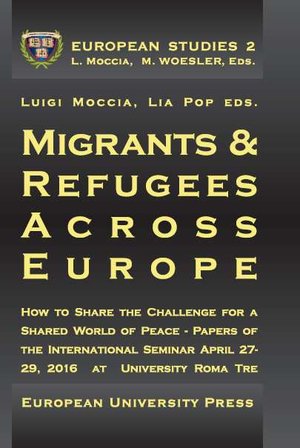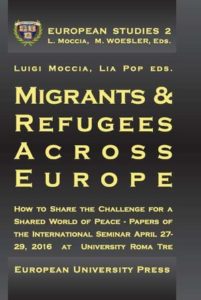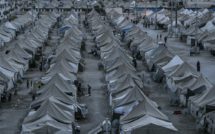

Various contributions have flourished in recent years regarding the current migration and refugee crisis, raising awareness among academics, practitioners, policy-makers, and public opinion. Identifying the major research trends and the most efficacious findings among them is not easy, given the multidisciplinary and multi-layered nature animating these debates. This book, edited by Luigi Moccia and Lia Pop, is an attempt to heighten awareness about the most debated features—the implications the crisis produces on the external borders of the EU and the effects on internal security, the daily life of European citizens, and their attitudes and openness towards the rest of the world. In other words, the authors of the book chapters help readers to understand what is changing in Europe because of this crisis, on a political and social level.
The book gathers a selection of papers presented during an international conference held at University Roma Tre in April 2016, and brings together scholars with different backgrounds and approaches. As clarified in the introduction by Luigi Moccia, the aim of gathering experts in the field is to launch a wider and open reflection on the future of a united Europe. Citizenship, borders, and identities are the key factors, which help to understand whether we will survive this challenge and continue to spread peace and prosperity to the rest of the world. To clearly describe the variety of approaches in some general trends, the book is divided into two parts. First, major issues and policies affecting the European level are clarified and analyzed. Second, individual and group rights, as well as national experiences, enrich the debate and complete the overall picture.
The first part demonstrates that the crisis has passed through different phases, requiring various tools and measures and involving a plethora of actors. Four main features and an obvious consequence can be observed. First, the crisis demonstrated the lack of a clear normative consensus among the EU members. States have lived with the conviction that the Dublin agreement and the rules about the right of asylum were the most efficient ones. Reality has shown that the need to balance the right of people to escape violence and conflicts and the right of states to rule their borders cannot always properly balanced (Palermo). Attempts to debate about the reform of the Dublin agreement (and its failures) are at the basis of the current fragility of the right of asylum and its application within the EU borders. This is all despite the fact that the refusal of reception — and its normative uncertainty — weakens any policy.
Secondly, the most difficult phase of the crisis, that is to say, the increase of arrivals by sea, has emphasized the humanitarian dimension and called for a more collective approach. Search and Rescue (SAR) Operations in the Central Mediterranean have become essential to saving lives and mitigating the inhuman side of the crisis (Panebianco). However, even in front of the humanitarian emergency, the EU migration management appears extremely constrained by intergovernmental preferences, stuck with the fear of losing control over borders, beyond any exercise of solidarity. On the one hand, a few coastal states and “willing” ones played a major role in rescuing people, while the failing performance of the EU mission, Triton (which was expected to replicate the excellent results of Mare Nostrum) was compensated by the proliferation of SAR operations led by non-governmental organizations. Among quarrels about its pertinence and legitimacy, “new” humanitarian practices arose and consolidated.
Third, the perception of crisis among citizens gradually changed. The assessment of a Eurobarometer survey data revealed how the citizens’ opinion on migration flows have developed (Attinà and Rossi), in line with the policies and official discourses made by leaders at European and national levels. Major events, like the signing of the Refugee Facility in Turkey, seriously affected the perception that the reception could affect daily routines. Therefore, the two-way relationship between public opinion and policy-makers also had an impact on leaders’ decision to opt for fencing the EU. Fourth, even though the deaths at sea were very visible through media, it became clear that integration policies are still essential and that member states have shifted their attention from them. Focusing on measures that allow and facilitate migrants and refugees’ access to the job market, as it has happened in some countries, like Germany and Sweden (Messmann), may appear a strategic choice. Investing on the valorization of the use of language as a way to integrate, instead of exclude or discriminate (Lia Pop), can be relevant as well. If providing immediate assistance and relief is absolutely essential for saving lives, then enhancing cultural mediation constitutes a rational way of preventing and avoiding conflicts while offering reliable and mutual alternatives. This requires a deep process of reform and adaptation of actual policies and tools, also including the ways through which integration is measured and assessed (Lopatin). Innovative criteria, consistently based on actual outcomes, may increase the success of integration and contribute (in the long-term) to the strengthening of solidarity among member states in the EU.
The obvious consequence is that the EU performance within its borders cannot influence its image with the rest of the world, nor remain a problem of internal security (Teodorescu). The crisis also has an effect on external migration policy, and shapes relations with other major political actors and international organizations. The boundaries between internal and external security have already demonstrated to be blurring, as also declared in the European Union Global Strategy. If maintaining a leading role in humanitarian action is crucial for the EU (and it is indeed sustained by data), the coherence and efficiency of partnerships with other actors should be one main concern.
The second part of the book complements the first, and adds a set of more specific and local perspectives, as well as a launch for future research trends. The experiences are obviously very diverse among member states. Some countries, like Italy, have developed a long and established tradition of reception (Fonzo), calibrated on different kinds of migrants, starting with Chinese communities (Riccardi). Others, like Germany, have tried to rationally bring migrants closer to host country culture via education and assistance into the job market (De Petris). Finally, those countries that have only recently become members, like Romania, demonstrate more difficulty in integrating people and mitigating the effect of radicalization and extremism, which are also nourished by media (Irina Pop).
Despite differences in the perception and approaches, there are some basic principles which constitute the groundwork of the European project, but, for their universality, they represent the groundwork of any kind of cooperation among entities which prefer to preserve peace instead of waging war. In a world that is continuously changing and developing, the centrality of human beings remains an immutable feature. More sophisticated political and legal debates on how to renovate and assure the protection of human rights (Omizzolo and Sodano), adequately stressing gender and LGBTI issues (Parisciani and Venturi), have shown that they cannot be taken for granted and that all European governments need to rediscover solidarity. This is not only a relevant principle within the European legal order, but also a tool which can apply in different ways and produce diverse outcomes (De Dominicis). As an obligation or a (moral) duty, it provides specific measures and, most importantly, it does not constitute a danger to sovereignty, rather it can be used to reinforce states’ preferences.
Both parts of the book reveal how the crisis is perceived, managed, and even communicated. As stated by Moccia, the main outcomes are up to European leaders and citizens. It is too easy to say that the migration and refugee challenge is a test on which the future of Europe will be shaped. However, it is true that only major crises can develop real capabilities and demonstrate if principles and ideals are really usable. Since Member states dominate their preferences and maintain their privilege to fence their borders, there is nothing new on the part of the EU. Despite this, the book launches an optimistic message that the EU will survive, that is to say, unions are fragile, but always constitute the best response to any problem.
Reviewed by Daniela Irrera, Università di Catania
Migrants & Refugees Across Europe
Edited by Luigi Moccia and Lia Pop
Publisher: European University Press
Hardcover / 433 pages / 2017
ISBN: 978-3-86515-249-7
To read more book reviews, please click here.
Published on July, 2 2018.




